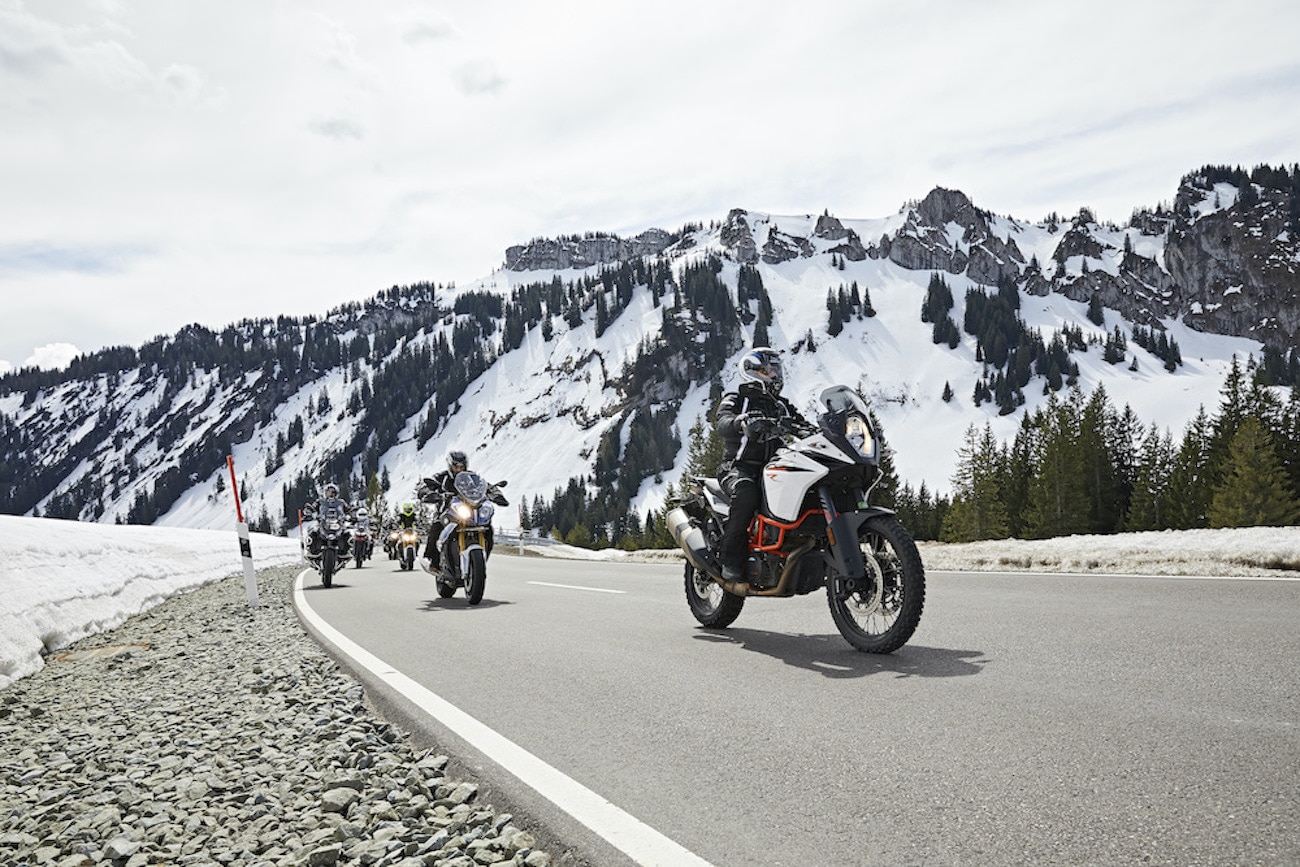For most of us, when winter hits, it’s time to park the bike in a garage, under a locked weather cover, or somewhere that is mostly safe, weather protected, and able to be accessed to plug in a trickle charger once every month to keep the battery happy. For others, however, they can keep riding all year around, but with the understanding that the ride is going to be cold and miserable. That is, unless they know what they need to wear or use to ride in cold weather.
Now, you may be wondering “Wait, you can ride in winter?” if you are in the Northern half of the continent, you could very well be asking that while looking out your window at a fresh snowfall, or the roads absolutely buried in slush and ice. For those people, technically you can, but you will need specific tires and bikes to do it, which is an entire article of its own. This article is more for those who have clear roads all year, maybe a day or two of sleet, and the rest of the time cold weather, cold pavement, and rain on the worst of days.
There are 7 important things you will need to ride in those types of conditions, so in no particular order, those are:
#1 Cold Weather Riding Gear
To ride comfortably and safely in cold weather, the first, and most important thing you need to consider is gear choice, especially layering gear correctly. Some jackets and pants for riding come with zip-out or push-button clasped thermal liners, especially in ADV gear, and are considered 3- or 4-season riding gear. However, when dressing warmly in the colder months, it is also important to keep in mind that as you are essentially creating a thermal shell around yourself, sweat will occur.
By layering a wicking base layer, or even, strange as it may sound, a cooling shirt underneath, effective management of sweat can make your ride not only much more comfortable, but also much safer. While in the warm and hot months, we welcome the airflow and wind we encounter when riding at 50+ MPH, in colder months that same airflow can wick away core heat faster than your body can regenerate it. Enough airflow over a long enough period of time, and you could potentially become hypothermic.
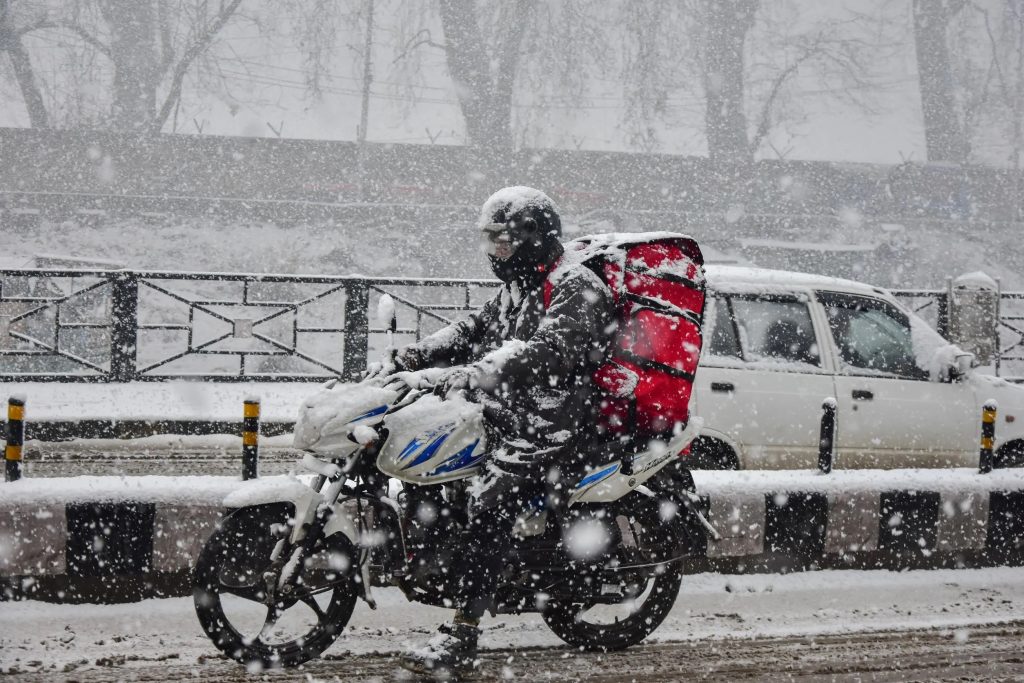
It is also essential, in these cases, to also have a water resistant or waterproof outer shell to your gear. Thankfully, most cold weather or ADV gear comes with some kind of Gore-Tex, HydraTex, or some other brand name concept of waterproofing that will keep you dry from the outside, but also let the sweat building breathe out through the membrane. This is especially important for your boots and gloves, as those are the areas where you control the motorcycle from. Good quality, waterproof boots and waterproof gloves with a decent level of insulation will make sure you arrive at your destination comfortably, instead of resting your hand on your engine case to get feeling back into your fingers at stop lights.
Also consider, if you live in a very wet or windy location in the winter months, some kind of neck gaiter or cover. It doesn’t have to be much, but as your carotid arteries travel near the surface of your neck, heat can be sapped from there as well. It is also vital to have a fog-free visor on your helmet, either through a pinlock-style system or, as with most Scorpion and some Shoei helmets, some type of anti-fog coating.
There is an option of using heated gear, but if something happens to the electrical connection mid-ride, you are left without a heating element. For this reason, layering is still the best option. Wicking/cooling shirt, a mid-layer if it’s particularly chilly, a thermal liner, waterproof top layer, and use the vents your gear has to control airflow to be comfortable in your ride.
#2 Proper Motorcycle Maintenance & Preparation For Cold Weather
You could be bundled up ready to face Antarctic temperatures, but if your bike isn’t prepped for cold weather, you won’t be going very far.
The most basic thing you need to prep on your bike is protection from the elements. By this, we’re meaning handguards, taller windshields, grippier/spiked pegs, and the like. It also, depending on just how cold it gets, might be worth investing in heated grips for your bike, if they did not come preinstalled. Some longer-distance touring and ADV bikes also have the option of a heated saddle, which could be worth it if you’re doing multi-day cold weather riding, but for the vast majority of people, proper gearing takes care of that anyways.
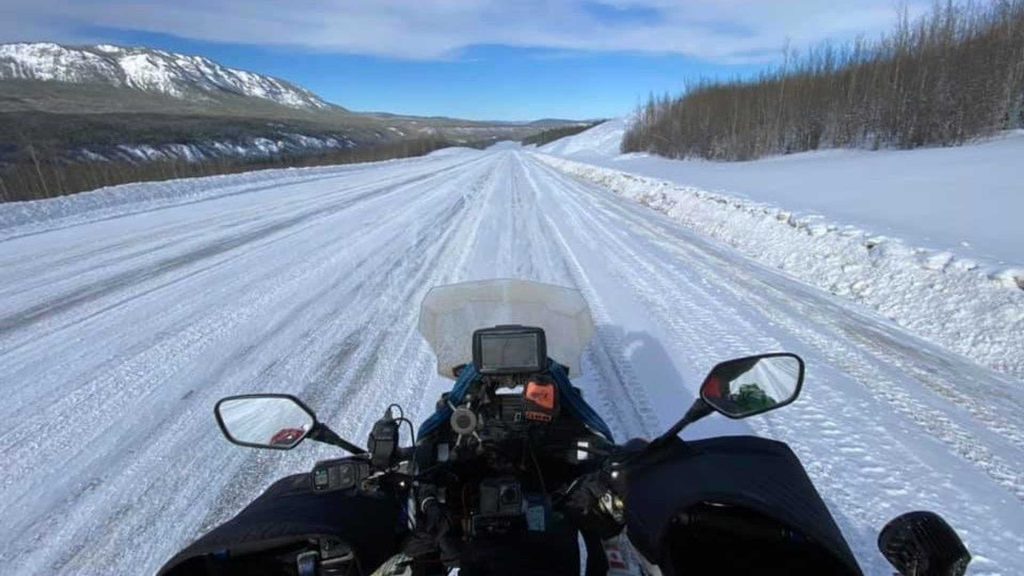
If your bike is water cooled, it is important to ensure that it has properly mixed, fresh antifreeze before each cold weather season. You really should be changing your coolant every year as part of maintenance anyways, so by including it in the prep for cold weather riding, you get two birds with one stone. During the coolant change, also inspect your coolant, fuel, and brake lines and hoses. Nothing will ruin your day more in cold weather than having a worn out hose pop off and start spraying coolant or other fluids all over your bike, you, and your tires.
#3 Colder Weather Means Cold-Weather Tires
It’s literally as simple as that: colder weather means colder pavement, meaning to get maximum grip, you need cold-weather tires. Those sticky summer tires that give you great grip in the dry will feel like dull ice-skate blades when the temperatures are dropping into the 20s, especially if you’re riding a supermoto or similar style “sport” bike. ADV and dual-sport bikes do have it a little easier here, as most of the tires made for them are like all-season car tires, able to be grippy from over 100 to under 30 degrees.
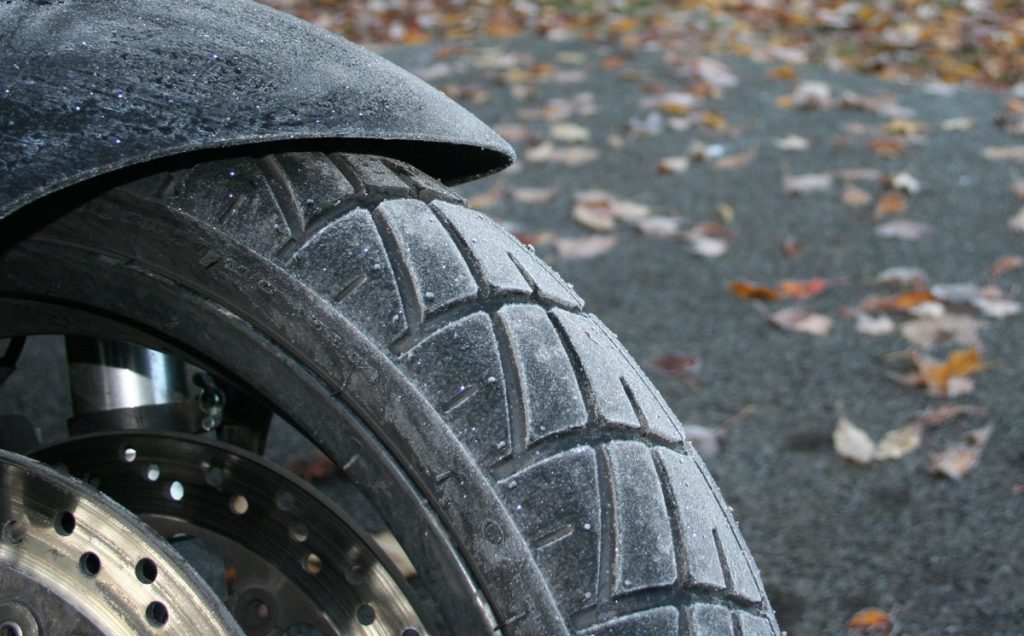
Also, you do need to generate heat in your tires, more so than in warmer months. To do this, do not sway back and forth in your lane, as while it does create some heat, it is heating the tires from the outside, and even a momentary stop can sap away all the heat generated. Instead, accelerate with purpose but not being an idiot, and then brake relatively hard but safely. Repeat this for a while when not on a major road, as the heat from the braking will travel through the metal of the rims and heat the tires from the inside, helping them retain more heat.
Lastly, always verify your tire pressures. In the summer, a slightly under- or over-inflated tire (2-5 PSI) will not affect your ride too much. In winter and colder weather riding, where it is expected to be somewhat wet from condensation, dew, rain, and the like, a properly inflated, cold weather tire with rain/snow sipes needs to be a the correct pressure to effectively channel that water/slush away from the contact patch, allowing your tires to grip. You should be doing a walkaround check of your bike every time you ride, so make checking your pressures part of that ritual, as well as have a battery power or hand powered pump with you in your backpack, tail bag, or pannier just in case.
#4 Eyes Up, Always Scanning, Watch For Sparkling/Glossy/Cracked Pavement
As you were likely taught in your MSF or other training course, “eyes to the horizon/20 seconds down the road, let your peripheral vision see everything else.” Over the course of your first season or two, you will find this saying making more and more sense as your brain gets used to scanning constantly using your peripheral vision, instead of you physically moving your eye.
What you need to learn to add to your internal library of things to scan for is pavement that appears to “sparkle,” which usually denotes salt or very recently formed/disturbed ice, and “glossy black” pavement, which usually means black ice or a puddle of water. It should be noted that these two types of pavement form either on the shoulder, from all the vehicles spraying freshly laid road salt off the main part of the road, or in deeper wheel troughs on less traveled roads respectively.
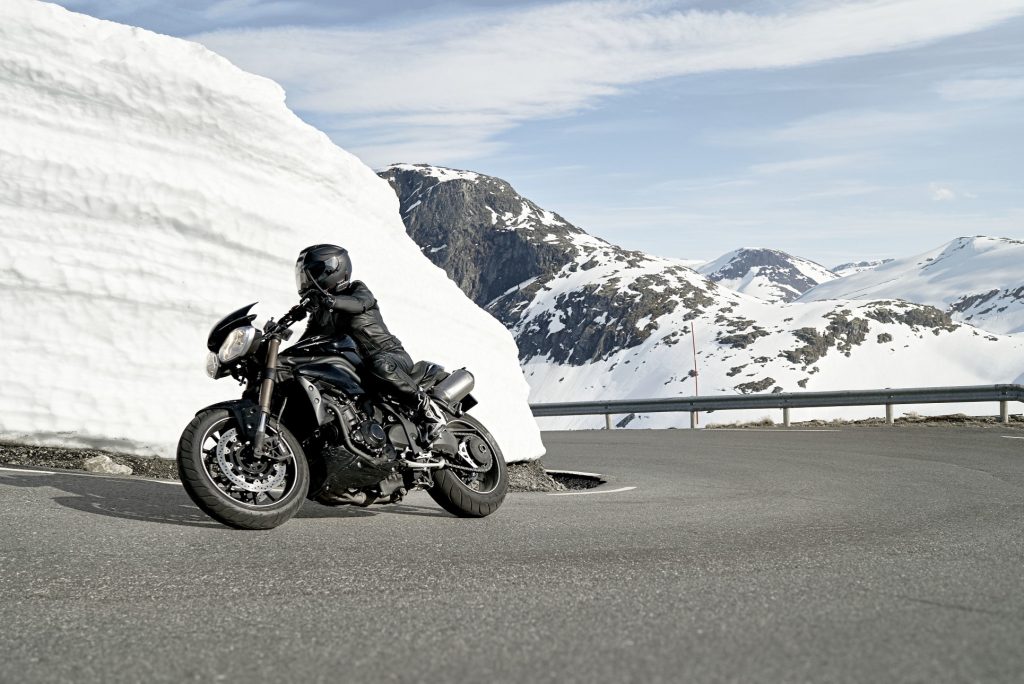
The true danger of cold weather riding, especially if you’re just on the border between rainy/slushy weather and actual snow, are cracks in the road. “Tar snakes” get very hard in the winter, and can act like a sheet of ice. As well, with snow plows possibly running in your area, keep in mind that they plow by running a blade of metal along the road surface that forces snow/slush to lift into a plastic or metal plow that chucks it off to the side of the road. That metal can rip up tar snakes, crack weather-heaved pavement, and can even polish thin layers of black ice to be deadly smooth.
Also, while on the subject of salt, motorcycles are generally not meant for winter riding, so giving the metal parts of your bike a good wash when the sun is out and it won’t freeze will help prevent rust. It is especially important to do your chain maintenance, sometimes even once per trip or once per full tank of gas, as salt loves to eat at the rubber gaskets that a sealed chain uses and can ruin a chain if not taken care of.
#5 Ride Like You Are Even More Invisible Than Normal
“Ride like you’re invisible” is a general guideline for every rider, novice to 40+ years veteran. Brightly colored gear, reflective strips, even a hi-viz safety vest worn over your jacket… it all helps grab attention so that people actually see you. Now, imagine that same concept in cold weather, when not only are people not actively looking for motorcycles, they are not actively expecting to see one either.
Increase your following distance, create more space for more escape routes and options to avoid road dangers. Ride with your lights on, even in the bright of day. Look 30 seconds down the road instead of 20. Don’t tailgate, speed, or even if it’s legal in your area, lane split or lane filter. Just don’t. Painted lines on the road become death traps in cold weather, and even touching a tire to one when you’re not expecting it can send you ass over handlebars in a hurry.
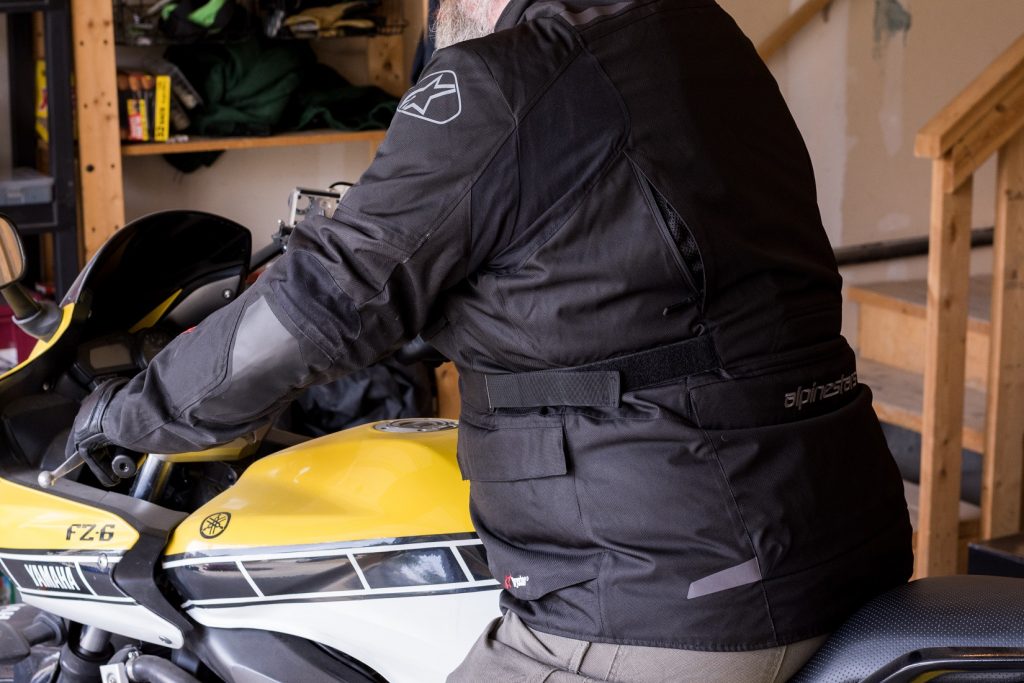
Perhaps most important of all, keep the idiot filter between your brain and right wrist firmly and permanently installed. With a car, if you spin up a tire, 3 other tires will carry you through the danger while you back off the gas until the tire grips. On a bike, spin up a tire on cold/wet/icy pavement, you are going to be meeting that pavement a moment later. Also, recognize and ride to the conditions. In summer, you should leave at least 5 car lengths between you and the vehicle ahead. In cold weather, double that to 10.
Think of it this way: In optimal conditions (summer, no clouds, dry as a bone, 80+ degrees, road freshly paved a month before), the average motorcycle equipped with ABS, traction control, and a veteran rider takes about 80 to 100 feet to stop from 35 MPH. With the average mid sized family car these days in the 16 to 22 foot range in terms of length, you would need at least 4 to 6 car lengths, in optimal conditions, to prevent hitting the back of that car if it needed to make an emergency stop.
#6 Do Not Be An Idiot
Just like the title says, don’t be an idiot. This is just reinforcing the permanent and fixed installation of your idiot filter between your brain and right wrist. This also means that if it is too dangerous to ride, take the car/public transit/taxi/uber/whatever instead. If you’re out riding and it starts to sleet or snow, end your ride and head home. If you’re far from home, park up as soon as you can to wait for the snow to pass or, in the worst case, have your “buddy with a truck” (we all have one!) come with a ramp and some straps to get your bike home.
It also means keeping a sharp eye on the forecast. Remember, when they are talking about the “possibility of precipitation/snow,” they aren’t talking about how likely it is to happen. The P.O.P. is how much of the area mentioned will be affected by said rain/sleet/snow. If there’s a 50% chance of snow, probably better to play it safe and take the car.
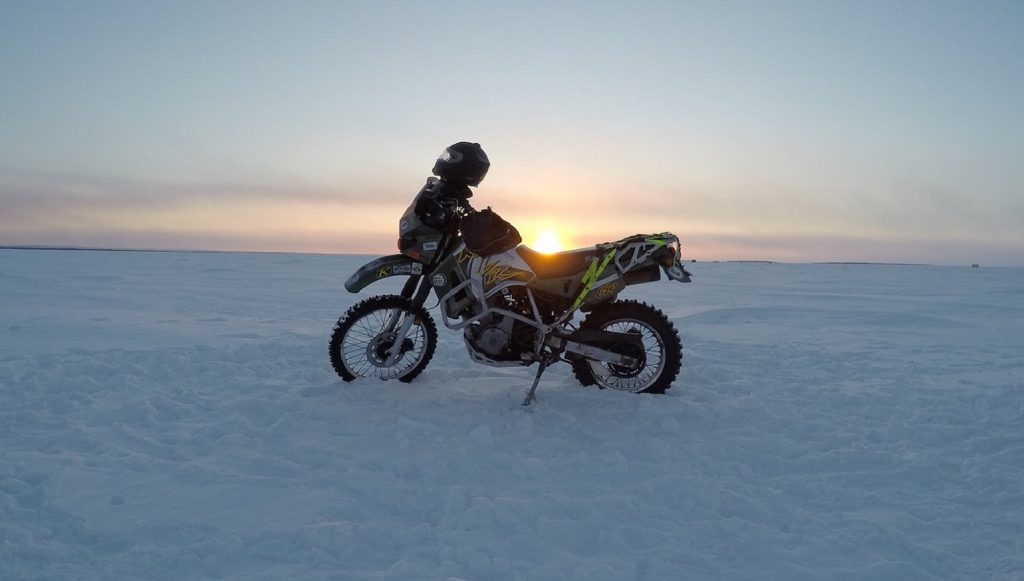
This section also means don’t push your luck. You might have an ADV or dual-sport bike with grippy, rain/sleet capable tires, but don’t go chucking yourself off-road onto a frozen lake in the middle of winter just because. For things like that, you need spiked or studded tires, and even then, if you’re in an area where it only freezes for a week at a time, that ice might be thinner than it looks. As the old saying goes, “measure twice, then measure again. Then cut once.”
#7 (Optional) Have Cold-Weather Riding Insurance/Roadside Assistance
Let’s not beat around the bush: Riding in cold weather is far more dangerous than riding during the “normal riding season” (in quotes as that may vary depending on where you live), to the point that some insurance companies will have the option of a “cold weather” rider you can add to your insurance. In most cases, this rider will cover heated components (grips, seat, heated gear), extra allowance for gear coverage (as you will be wearing more layers and more resilient, hence sometimes more expensive, gear), as well as include higher single-vehicle accident coverage and liability.
If your insurance covers all of that already, good on you for having a good plan. What most insurance does not cover, however, is vehicle recovery after a single- or multiple-vehicle accident. In this case, having a roadside assistance plan that specifically covers motorcycle recovery or roadside repair is invaluable. The American Motorcyclist Association does have a 52-state roadside assistance plan you can purchase, and it can be a big relief to have a truck arrive with a new tire for your bike, or a two truck with a motorcycle sling or even a flatbed to get you out of a tough spot.

